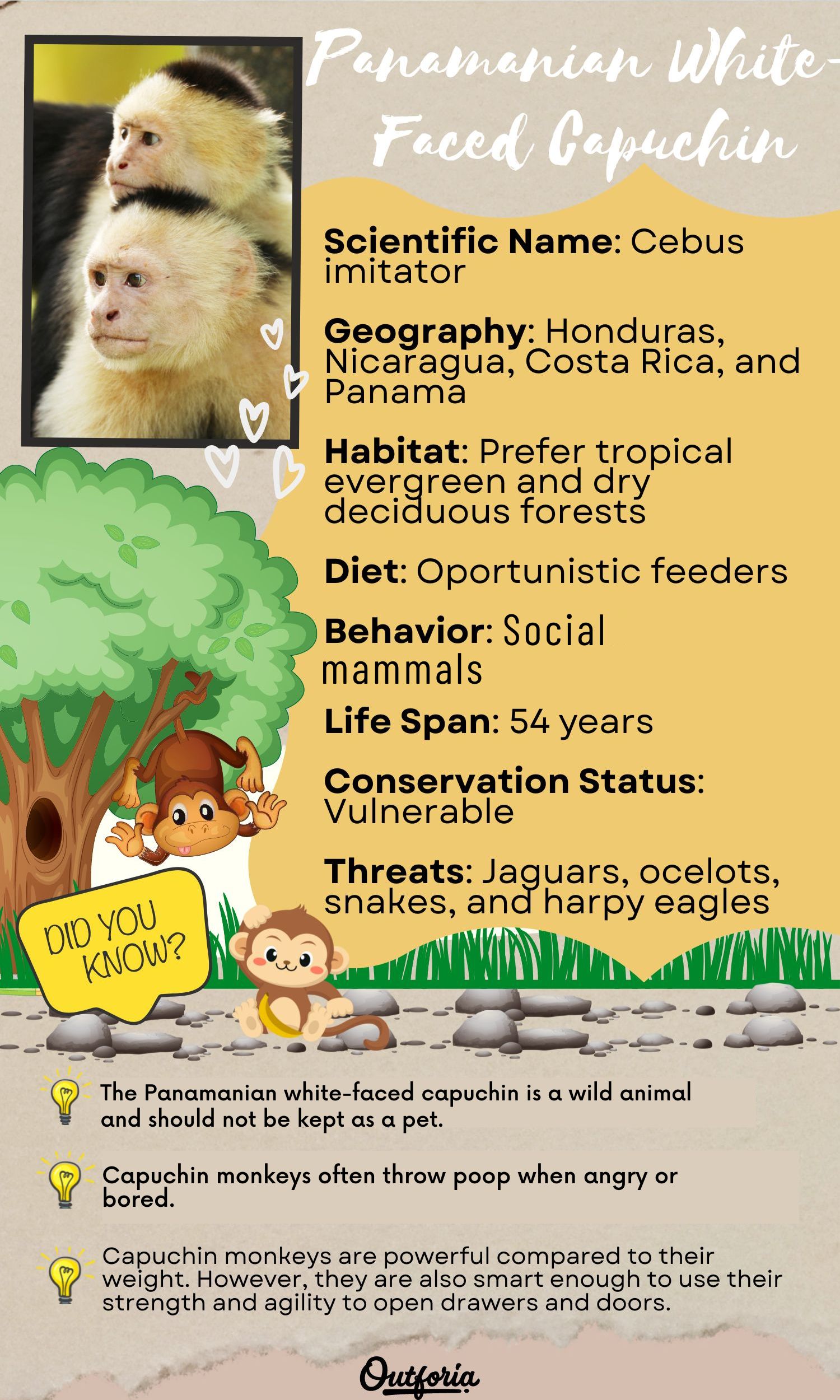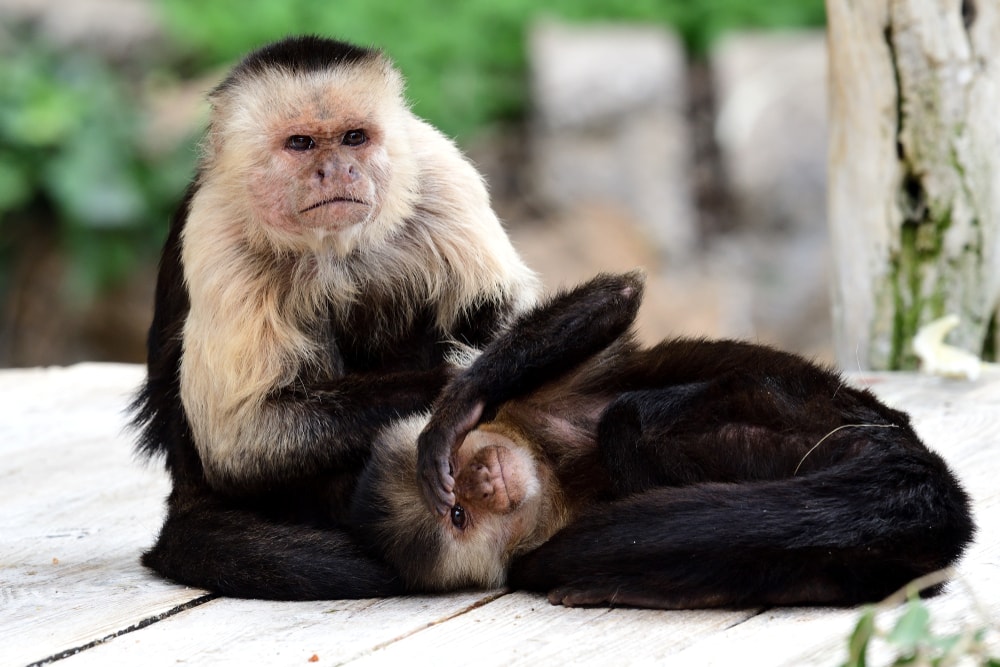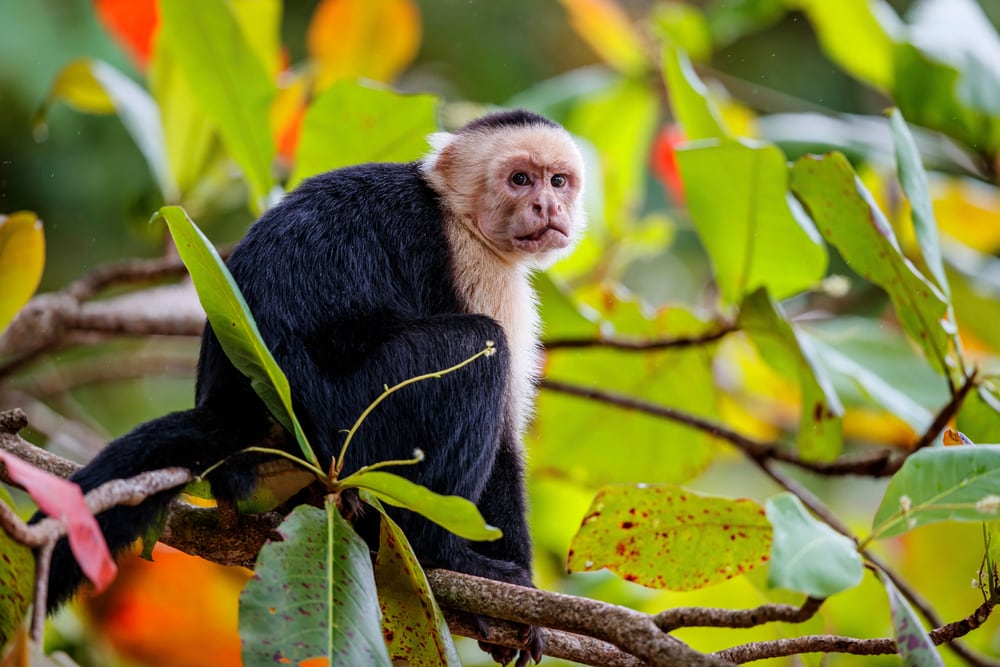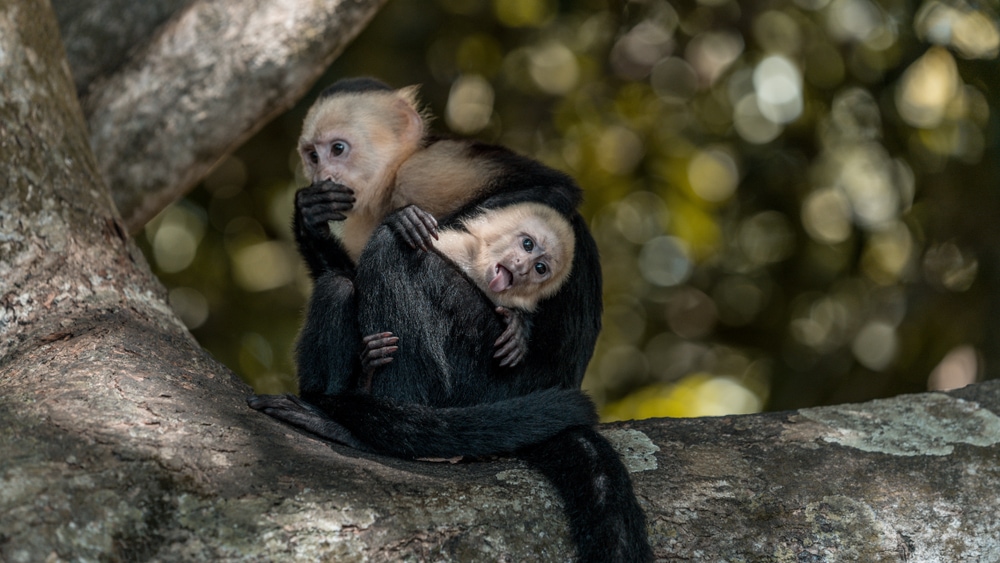Outforia Quicktake: Key Takeaways
- Panamanian white-faced capuchins are intelligent, social primates native to Central America.
- They have a diverse diet, including fruits, nuts, and small animals, and use tools to access food and defend themselves.
- These monkeys live in groups, with complex social structures based on ranking and kinship.
- White-faced capuchins are vulnerable due to deforestation and the pet trade, with natural predators like jaguars, snakes, and harpy eagles also posing threats.
- They play an essential ecological role in their habitat, dispersing seeds and pollen, and helping control insect pests.
The Panamanian white-faced monkey is one of the most recognized monkeys in the world. It has an unique and adorable appearance that has won it a notable TV presence. But there’s more to this monkey than just a pretty face.
Did you know that the white-faced capuchin is one of the most intelligent monkeys? It can use tools to get food and defend itself against predators. Amazing, right? Let’s find out more about these primates.

SHARE THIS IMAGE ON YOUR SITE
<a href="https://outforia.com/panamanian-white-faced-capuchin/"><img style="width:100%;" src="https://outforia.com/wp-content/uploads/2022/11/panamanian-white-faced-capuchin-infographics-10112022-1.jpg"></a><br>Panamanian White-Faced Capuchin <a href="https://outforia.com">Outforia</a>Capuchin Monkey Classification

This cheeky type of monkey was initially considered the same species as the Columbian white-faced monkey. It was placed under a different subspecies, C. capucinus imitator. However, in a 2012 study, scientists discovered that these two species actually split up 2 million years ago.
The Panamanian white-faced capuchin (Cebus imitator) is a New World monkey. It belongs to the Cebidae family, which includes capuchin and squirrel monkeys. Further studies placed it in the Cebinae subfamily, where it has become the most studied capuchin monkey species.
Other known names for the Panamanian white-faced capuchin are:
- The Panamanian white-headed capuchin
- The Central American white-faced capuchin
You May Also Like: How Long Do Monkeys Live? From Old World To New World
Appearance and Size

The Panamanian white-faced capuchin got its name after the Capuchin friars. They were a religious order of Franciscan friars in Italy. Their cowls have the same coloration as the monkey’s head. Thus it was easy for explorers of the New World to come up with a name for this adorable monkey when they encountered it.
This monkey is easily distinguished by its fur coloration. Its tiny body is covered in black fur and yellowish-white hair on the neck, throat, chest, and upper arms.
It has a pink or white face, and some have distinct marks or dark patches. It also spots dark fur on the crown of the head.
The Panamanian white-faced capuchin has the nickname ringtail because they curl their tails. It is also called a prehensile tail because they use it to grasp things such as branches to move from tree to tree.
The size of an adult capuchin monkey varies between 13 to 17 inches (330 to 450 mm), ignoring the tail. The length of their tails surpasses their bodies, reaching up to 21 inches (550 mm) in length.
The capuchin monkey weighs up to 8 pounds (3.6 kg), and the males are significantly larger than the females by 27%. What’s interesting about this species is that their brains are larger than other species of monkeys. For example, the mantled howler monkey is bigger but has a smaller brain.
The Panamanian white-faced capuchin and the Columbian white-faced capuchin look very similar. However, the female Panamanian white-headed capuchin has brownish frontal tufts.
Geography, Distribution & Location

The Panamanian white-faced capuchins are native to the forests of Central America. They can be seen in Honduras, Nicaragua, Costa Rica, and Panama. Central America’s National parks are filled with them. They are the most common monkeys in parks such as Santa Rosa National Park and Corcovado National Park.
They are most common in Costa Rica and Panama, even appearing on the Costa Rican 5,000-colon bank note. In mainland Honduras and Nicaragua, their population has been mostly wiped out. Many of the remaining capuchins from Honduras were relocated to Roatan island, and the ones from Nicaragua to the island of Ometepe.
White-Headed Capuchin Habitat

They are highly adaptable monkeys that can live in various habitats. They usually live in tropical evergreen and dry deciduous forests.
They can also live in both primary and secondary forests, but they favor the former over the latter. Capuchins are usually found in the older parts of the forest, where they have enough water during the dry season.
Diet & Feeding Habits

White-faced capuchins aren’t picky eaters, going for various plants and animals. Their primary diet consists of fruits and nuts. But they are also opportunistic feeders. Capuchins eat vertebrates such as squirrels, tree rats, and birds. Their diet changes seasonally, but they usually eat 50 to 80% fruits, 20% animals, and 10% plant material.
For example, the white-faced capuchins in Costa Rica will eat various fruits and caterpillars during the rainy season.
During the dry season, their diet adapts to figs and a few available fruits. During this season, they also compete for water holes, as the capuchins like to drink water daily.
These clever monkeys are adventurous regarding food and like to try everything once. They use trial and error to work out what to eat. They become excellent foragers from a young age. As little as one year old, their only limitation is their size and strength.
Behavior
Social Structures

The Panamanian white-faced capuchins are diurnal animals. It means they hunt and socialize during the day and sleep at night. They are also arboreal but like to spend more time on the ground than other New World monkeys. They usually walk on all four limbs.
As highly sociable mammals, they live in groups of approximately 40 monkeys. Females usually remain within the same group their entire lives. However, males are migratory, switching groups multiple times during their life. Their first migration can start as early as four years old.
What’s unusual about these primates is that most group members are related. It is because alpha males sire almost all of the offspring.
An alpha male can reign for up to 17 years. He will breed with the offspring of his daughters and granddaughters. The result is many paternal half-siblings and full siblings, which other primates don’t achieve.
The female organizational structures are interesting in their own way. For example, females usually associate with and groom other females on their mother’s side. They tend to avoid paternal half-sisters. It shows that they recognize kinship through the maternal line.
Their overall social structure gets formed through ranking. Females and males associate with other capuchins close in the dominance hierarchy.
When they fight, they will generally request help from similar ranking capuchins. It shows that they understand how alliance structure works.
Usually, the male is more dominant than the female, and male-to-male relationships are more rigid as grooming is not involved.
However, males will cooperate to defend the group from predators and other males. Male capuchins are highly aggressive. Having other male allies during migration is necessary for survival.
Social Interactions

Scientists have observed some strange behaviors that capuchins regularly exhibit, like eye-poking, tail-sucking, hand-sniffing, and finger-biting, among others. They are usually performing them to strengthen the bond within the group.
Finger-biting is the strangest and most observed behavior. It looks as if they are playing a game where one capuchin inserts its finger into the closed mouth of another and then tries to open it.
When it succeeds, they change roles. These weird customs usually stop after seven to ten years of age. Researchers assume it’s because the bond is considerably strong by that time.
These tiny monkeys are very loud. They make high-pitched calls to warn others of threats, including barks and coughs. They have different vocalizations for different threats. When they are intimate, they use softer calls.
Another way they communicate is through facial expressions and scent. For example, they sometimes rub urine on their feet, which is called urine washing. Scientists are baffled by this behavior but believe it is some olfactory signal.
You May Also Like: Golden Snub-Nosed Monkey: All About The Monkey Who Loves Snow
The Most Intelligent New World Species

White-faced capuchin monkeys are considered the most intelligent New World monkeys. Their behavior and intelligence have been heavily studied. They have been observed to use tools to make their lives easier.
Capuchins from Coiba National Park in Panama use hammerstones to break fruits such as coconuts. They also use this tool on invertebrates like the hermit crabs. They can also use tools to defend themselves, using sticks to kill snakes. They also use sticks to explore holes.
Some capuchins have been seen rubbing plants into their hair. Scientists are not entirely sure why they do this, but they believe it may deter parasites like ticks.
Due to their intelligence and the ability to use tools, they can be trained to assist people with paraplegia. For example, they help people who use wheelchairs by retrieving objects, turning on lights, and even turning pages of books.
They can also be trained to appear in movies and TV shows. They’ve become popular in Hollywood due to “Pirates of the Caribbean,” where Captain Barbosa has Jack, the monkey, as a pet. In the “Friends” series, Ross has a pet capuchin named Marcel.
Mating Habits & Reproduction

These tiny primates are polygamous, so a male capuchin can mate with many females. Although a female can copulate with multiple males, the dominant male will mate with her when she is the most fertile.
While the alpha male fathers the most juveniles, he usually doesn’t mate with his daughters. This habit is rare among New World monkeys. The gestation lasts six months, and the female gives birth to only one baby, although sometimes they can have twins.
Life Cycle and Lifespan

Births take place from December to April during the dry season. The infant will stay on its mother’s back for about six months.
They become slightly more curious at five weeks old and can stray briefly from their mothers. They are more independent at three months old. Between six to ten months, they start forming bonds with other juveniles.
The mother usually gets help from other capuchins when raising the juvenile. This practice is called alloparenting. Both males and females engage in taking care of the youths.
White-faced capuchins mature slowly, reaching sexual maturity at three years old. The female will give birth at seven years old and then give birth every two years. Males usually reproduce when they are ten years old.
Capuchins live long lives because of their small size. The oldest known capuchin was over 54 years old, but it was kept in captivity in an ideal environment.
Population

Their population number is currently unavailable. No official or open source provides an estimate.
Conservation Status

According to IUCN, these species don’t make it on the official threatened species list. However, they are seen as vulnerable because of deforestation and the pet trade.
Threats and Predators

Their main threat is humans because capuchins are hunted for food or captured and sold for the pet trade.
In addition, white-faced capuchins are known carriers of malaria and microfilaria. It can be deadly for infants and young children. They also face habitat loss from deforestation.
Their natural predators are snakes, mainly tree boas and lanceheads. Other animals that prey on this species include jaguars, ocelots, and harpy eagles. When a group feels threatened, they will flee or mob the predator.
Ecological Role

Panamanian white-faced capuchins play an essential role in their ecosystem. They help the forest regenerate by dispersing seeds and pollen. Another way they help the trees is by eating certain insects regarded as pests. In return, the trees can regenerate more branches and make more fruit.
White-Headed Capuchin Facts

Victorians used capuchin monkeys as organ grinders. They performed tricks to attract attention and went around to spectators to collect money.
Some female capuchins will throw rocks at males to initiate intercourse. Scientists believe one female was the trendsetter, and the rest copied.
Capuchin monkeys are very fast. They can run up to 35 miles (56 km) per hour.
Capuchin monkeys like to rub themselves with onions. Scientists aren’t sure why but they believe the behavior is medicinal.
You May Also Like: Proboscis Monkey: All About These Long-Nosed Primates
FAQ

Can you have a Panamanian white-faced capuchin as a pet?
The Panamanian white-faced capuchin is a wild animal and should not be kept as a pet. They carry diseases, and their behavior is unpredictable, so it’s hard to train them.
How much is a Panamanian white-faced capuchin?
Bought from reputable breeders, this New World monkey can cost $5,000 to $7,000.
Do capuchin monkeys throw poop?
Capuchin monkeys often throw poop when angry or bored.
What is the easiest monkey to take care of?
All monkeys are challenging to take care of. They aren’t docile as cats and dogs and require plenty of space, a diverse diet full of nutrients, and an absurd amount of attention.
Are capuchin monkeys strong?
Capuchin monkeys are powerful compared to their weight. However, they are also smart enough to use their strength and agility to open drawers and doors.









